sunroof BMW 335I SEDAN 2012 Owners Manual
[x] Cancel search | Manufacturer: BMW, Model Year: 2012, Model line: 335I SEDAN, Model: BMW 335I SEDAN 2012Pages: 325, PDF Size: 12.26 MB
Page 15 of 325
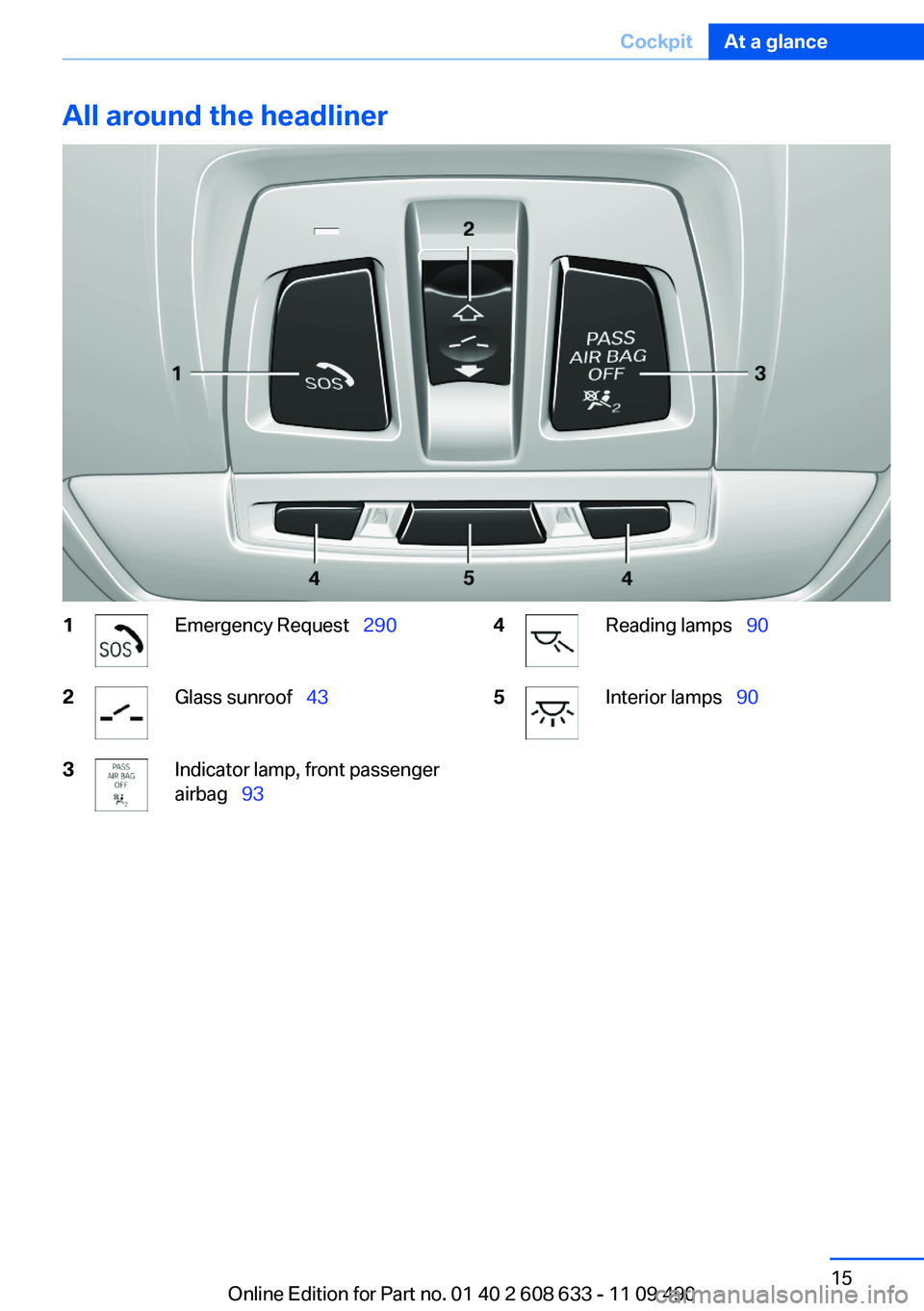
All around the headliner1Emergency RequestтАВтАЕ2902Glass sunroofтАВтАЕ433Indicator lamp, front passenger
airbagтАВтАЕ 934Reading lampsтАВтАЕ 905Interior lampsтАВтАЕ90Seite 15CockpitAt a glance15
Online Edition for Part no. 01 40 2 608 633 - 11 09 490
Page 34 of 325
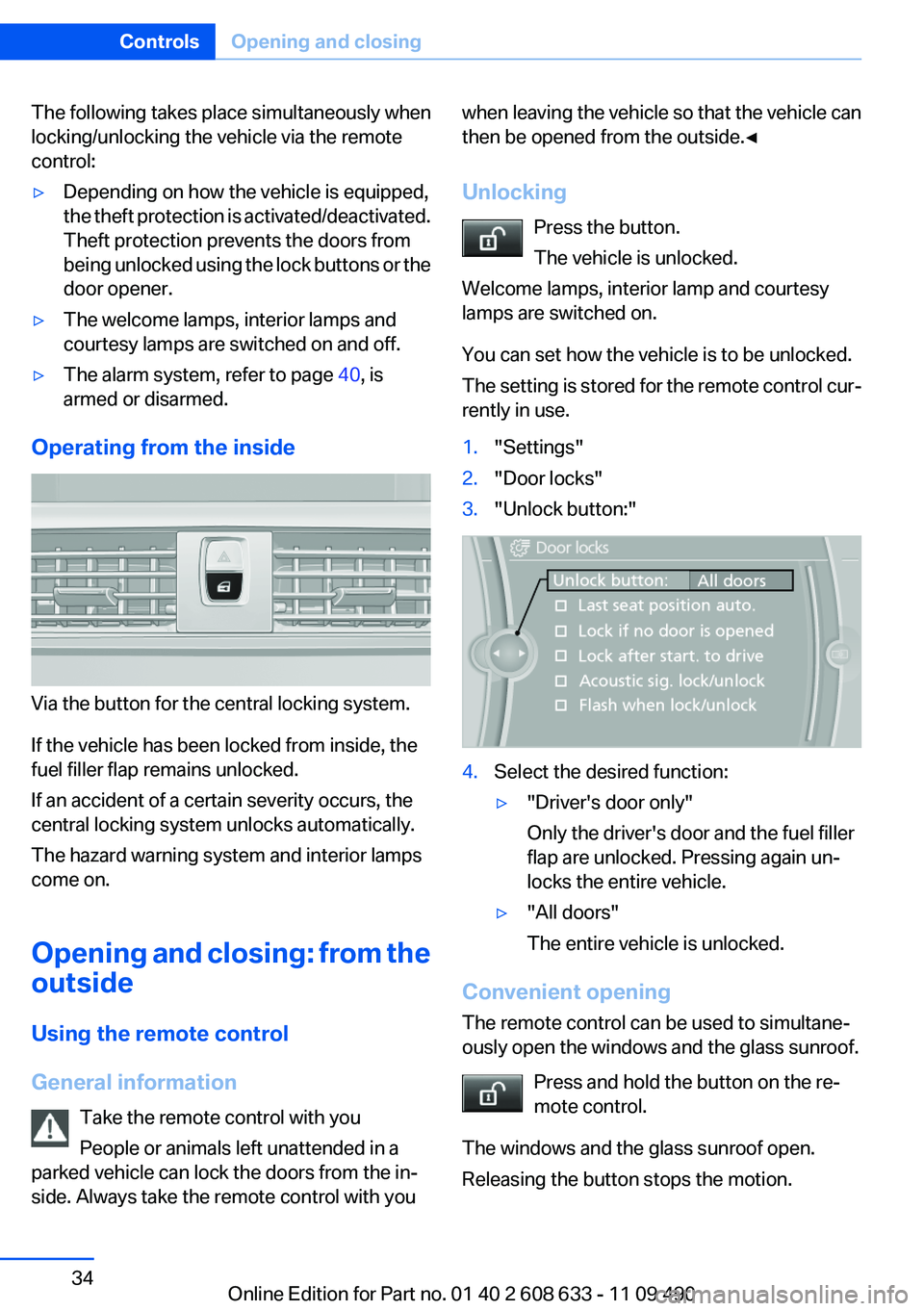
The following takes place simultaneously when
locking/unlocking the vehicle via the remote
control:тЦ╖Depending on how the vehicle is equipped,
the theft protection is activated/deactivated.
Theft protection prevents the doors from
being unlocked using the lock buttons or the
door opener.тЦ╖The welcome lamps, interior lamps and
courtesy lamps are switched on and off.тЦ╖The alarm system, refer to page 40, is
armed or disarmed.
Operating from the inside
Via the button for the central locking system.
If the vehicle has been locked from inside, the
fuel filler flap remains unlocked.
If an accident of a certain severity occurs, the
central locking system unlocks automatically.
The hazard warning system and interior lamps
come on.
Opening and closing: from the
outside
Using the remote control
General information Take the remote control with you
People or animals left unattended in a
parked vehicle can lock the doors from the inтАР
side. Always take the remote control with you
when leaving the vehicle so that the vehicle can
then be opened from the outside.тЧА
Unlocking Press the button.
The vehicle is unlocked.
Welcome lamps, interior lamp and courtesy
lamps are switched on.
You can set how the vehicle is to be unlocked.
The setting is stored for the remote control curтАР
rently in use.1."Settings"2."Door locks"3."Unlock button:"4.Select the desired function:тЦ╖"Driver's door only"
Only the driver's door and the fuel filler
flap are unlocked. Pressing again unтАР
locks the entire vehicle.тЦ╖"All doors"
The entire vehicle is unlocked.
Convenient opening
The remote control can be used to simultaneтАР
ously open the windows and the glass sunroof.
Press and hold the button on the reтАР
mote control.
The windows and the glass sunroof open.
Releasing the button stops the motion.
Seite 34ControlsOpening and closing34
Online Edition for Part no. 01 40 2 608 633 - 11 09 490
Page 39 of 325
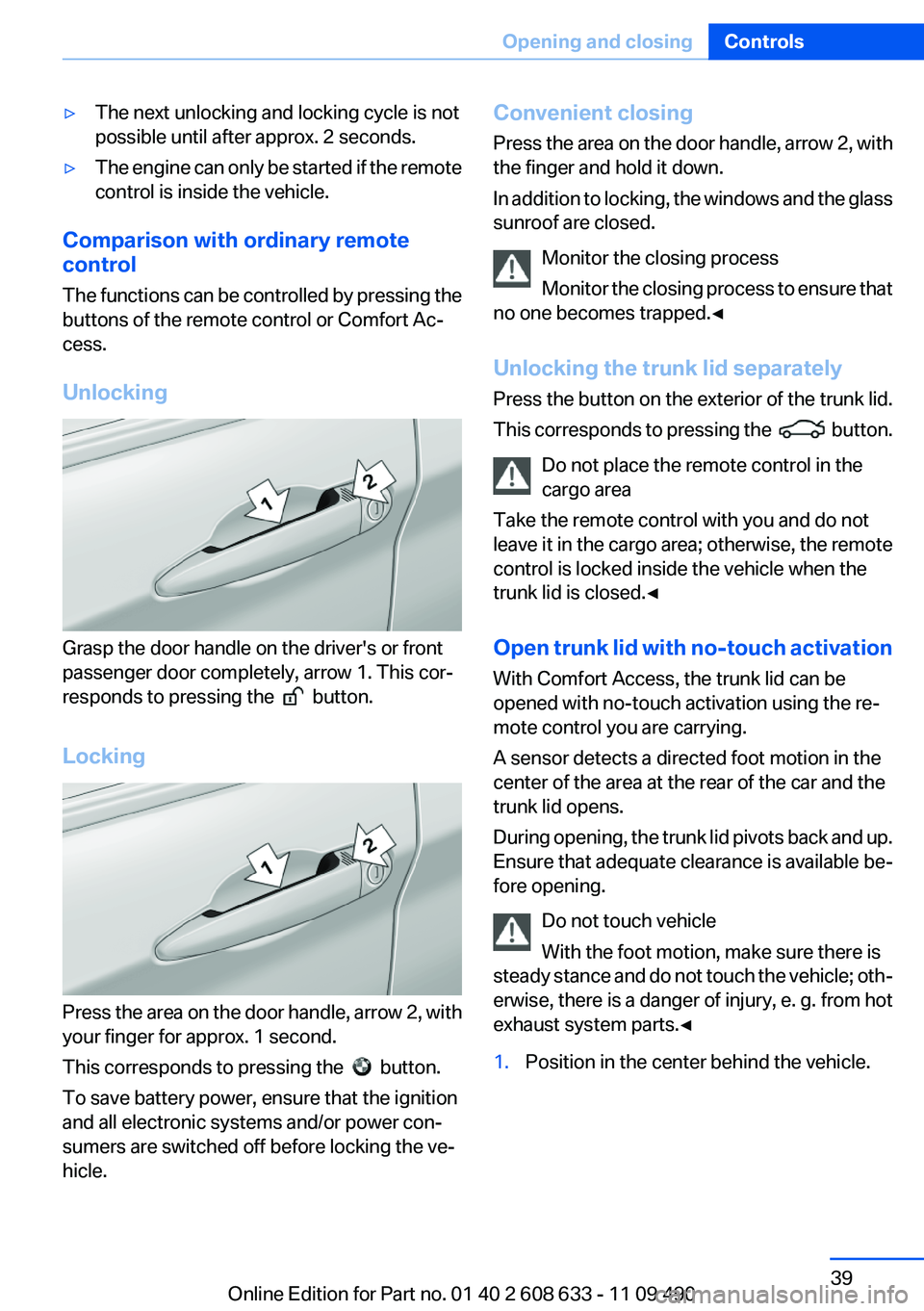
тЦ╖The next unlocking and locking cycle is not
possible until after approx. 2 seconds.тЦ╖The engine can only be started if the remote
control is inside the vehicle.
Comparison with ordinary remote
control
The functions can be controlled by pressing the
buttons of the remote control or Comfort AcтАР
cess.
Unlocking
Grasp the door handle on the driver's or front
passenger door completely, arrow 1. This corтАР
responds to pressing the
button.
Locking
Press the area on the door handle, arrow 2, with
your finger for approx. 1 second.
This corresponds to pressing the
button.
To save battery power, ensure that the ignition
and all electronic systems and/or power conтАР
sumers are switched off before locking the veтАР
hicle.
Convenient closing
Press the area on the door handle, arrow 2, with
the finger and hold it down.
In addition to locking, the windows and the glass
sunroof are closed.
Monitor the closing process
Monitor the closing process to ensure that
no one becomes trapped.тЧА
Unlocking the trunk lid separately
Press the button on the exterior of the trunk lid.
This corresponds to pressing the
button.
Do not place the remote control in the
cargo area
Take the remote control with you and do not
leave it in the cargo area; otherwise, the remote
control is locked inside the vehicle when the
trunk lid is closed.тЧА
Open trunk lid with no-touch activation
With Comfort Access, the trunk lid can be
opened with no-touch activation using the reтАР
mote control you are carrying.
A sensor detects a directed foot motion in the
center of the area at the rear of the car and the
trunk lid opens.
During opening, the trunk lid pivots back and up.
Ensure that adequate clearance is available beтАР
fore opening.
Do not touch vehicle
With the foot motion, make sure there is
steady stance and do not touch the vehicle; othтАР
erwise, there is a danger of injury, e. g. from hot
exhaust system parts.тЧА
1.Position in the center behind the vehicle.Seite 39Opening and closingControls39
Online Edition for Part no. 01 40 2 608 633 - 11 09 490
Page 41 of 325
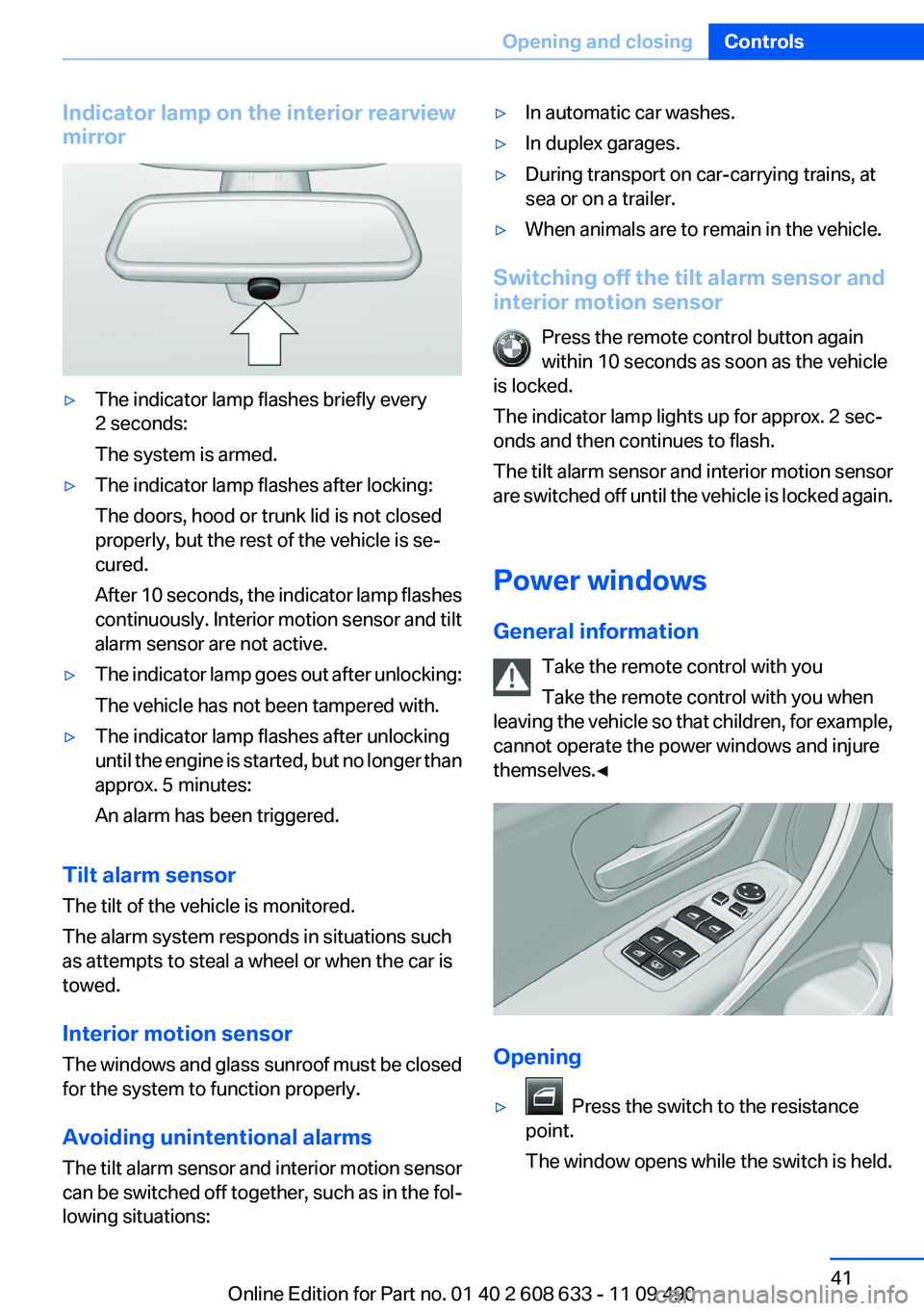
Indicator lamp on the interior rearview
mirrorтЦ╖The indicator lamp flashes briefly every
2 seconds:
The system is armed.тЦ╖The indicator lamp flashes after locking:
The doors, hood or trunk lid is not closed
properly, but the rest of the vehicle is seтАР
cured.
After 10 seconds, the indicator lamp flashes
continuously. Interior motion sensor and tilt
alarm sensor are not active.тЦ╖The indicator lamp goes out after unlocking:
The vehicle has not been tampered with.тЦ╖The indicator lamp flashes after unlocking
until the engine is started, but no longer than
approx. 5 minutes:
An alarm has been triggered.
Tilt alarm sensor
The tilt of the vehicle is monitored.
The alarm system responds in situations such
as attempts to steal a wheel or when the car is
towed.
Interior motion sensor
The windows and glass sunroof must be closed
for the system to function properly.
Avoiding unintentional alarms
The tilt alarm sensor and interior motion sensor
can be switched off together, such as in the folтАР
lowing situations:
тЦ╖In automatic car washes.тЦ╖In duplex garages.тЦ╖During transport on car-carrying trains, at
sea or on a trailer.тЦ╖When animals are to remain in the vehicle.
Switching off the tilt alarm sensor and
interior motion sensor
Press the remote control button again
within 10 seconds as soon as the vehicle
is locked.
The indicator lamp lights up for approx. 2 secтАР
onds and then continues to flash.
The tilt alarm sensor and interior motion sensor
are switched off until the vehicle is locked again.
Power windows
General information Take the remote control with you
Take the remote control with you when
leaving the vehicle so that children, for example,
cannot operate the power windows and injure
themselves.тЧА
Opening
тЦ╖ Press the switch to the resistance
point.
The window opens while the switch is held.
Seite 41Opening and closingControls41
Online Edition for Part no. 01 40 2 608 633 - 11 09 490
Page 43 of 325
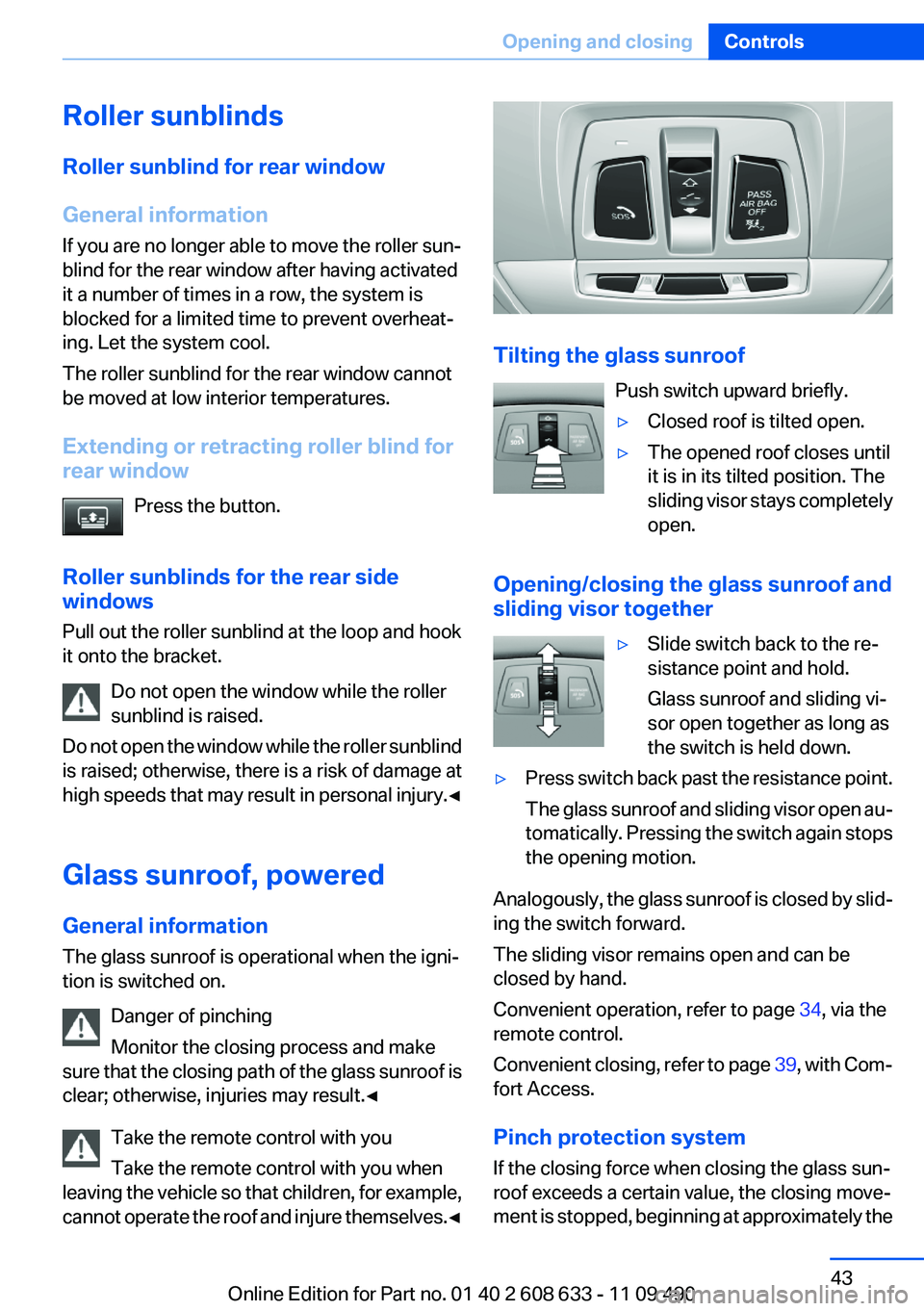
Roller sunblinds
Roller sunblind for rear window
General information
If you are no longer able to move the roller sunтАР
blind for the rear window after having activated
it a number of times in a row, the system is
blocked for a limited time to prevent overheatтАР
ing. Let the system cool.
The roller sunblind for the rear window cannot
be moved at low interior temperatures.
Extending or retracting roller blind for
rear window
Press the button.
Roller sunblinds for the rear side
windows
Pull out the roller sunblind at the loop and hook
it onto the bracket.
Do not open the window while the roller
sunblind is raised.
Do not open the window while the roller sunblind
is raised; otherwise, there is a risk of damage at
high speeds that may result in personal injury. тЧА
Glass sunroof, powered
General information
The glass sunroof is operational when the igniтАР
tion is switched on.
Danger of pinching
Monitor the closing process and make
sure that the closing path of the glass sunroof is
clear; otherwise, injuries may result.тЧА
Take the remote control with you
Take the remote control with you when
leaving the vehicle so that children, for example,
cannot operate the roof and injure themselves. тЧА
Tilting the glass sunroof
Push switch upward briefly.
тЦ╖Closed roof is tilted open.тЦ╖The opened roof closes until
it is in its tilted position. The
sliding visor stays completely
open.
Opening/closing the glass sunroof and
sliding visor together
тЦ╖Slide switch back to the reтАР
sistance point and hold.
Glass sunroof and sliding viтАР
sor open together as long as
the switch is held down.тЦ╖Press switch back past the resistance point.
The glass sunroof and sliding visor open auтАР
tomatically. Pressing the switch again stops
the opening motion.
Analogously, the glass sunroof is closed by slidтАР
ing the switch forward.
The sliding visor remains open and can be
closed by hand.
Convenient operation, refer to page 34, via the
remote control.
Convenient closing, refer to page 39, with ComтАР
fort Access.
Pinch protection system
If the closing force when closing the glass sunтАР
roof exceeds a certain value, the closing moveтАР
ment is stopped, beginning at approximately the
Seite 43Opening and closingControls43
Online Edition for Part no. 01 40 2 608 633 - 11 09 490
Page 44 of 325
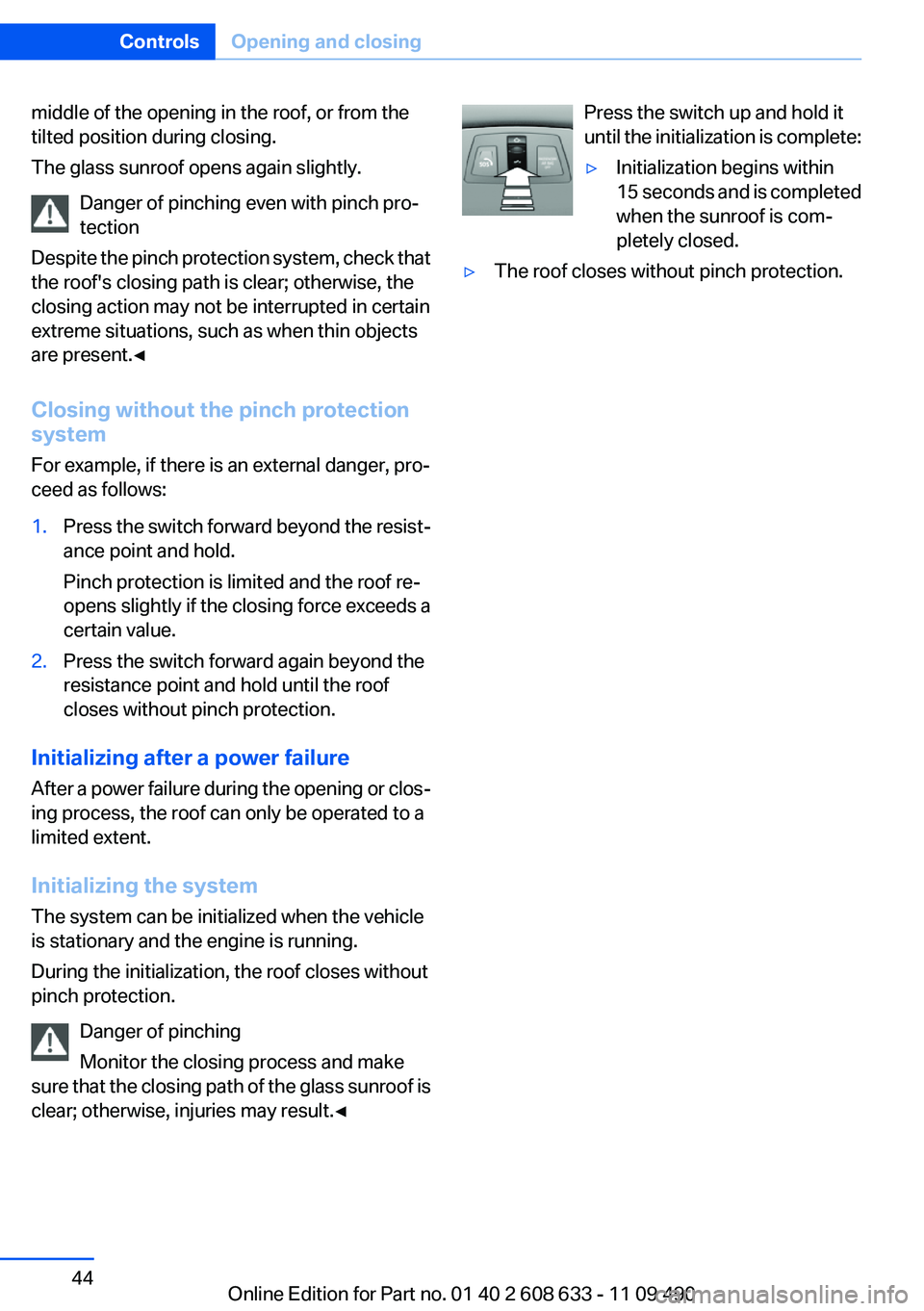
middle of the opening in the roof, or from the
tilted position during closing.
The glass sunroof opens again slightly.
Danger of pinching even with pinch proтАР
tection
Despite the pinch protection system, check that
the roof's closing path is clear; otherwise, the
closing action may not be interrupted in certain
extreme situations, such as when thin objects
are present.тЧА
Closing without the pinch protection
system
For example, if there is an external danger, proтАР
ceed as follows:1.Press the switch forward beyond the resistтАР
ance point and hold.
Pinch protection is limited and the roof reтАР
opens slightly if the closing force exceeds a
certain value.2.Press the switch forward again beyond the
resistance point and hold until the roof
closes without pinch protection.
Initializing after a power failure
After a power failure during the opening or closтАР
ing process, the roof can only be operated to a
limited extent.
Initializing the system
The system can be initialized when the vehicle
is stationary and the engine is running.
During the initialization, the roof closes without
pinch protection.
Danger of pinching
Monitor the closing process and make
sure that the closing path of the glass sunroof is
clear; otherwise, injuries may result.тЧА
Press the switch up and hold it
until the initialization is complete:тЦ╖Initialization begins within
15 seconds and is completed
when the sunroof is comтАР
pletely closed.тЦ╖The roof closes without pinch protection.Seite 44ControlsOpening and closing44
Online Edition for Part no. 01 40 2 608 633 - 11 09 490
Page 103 of 325
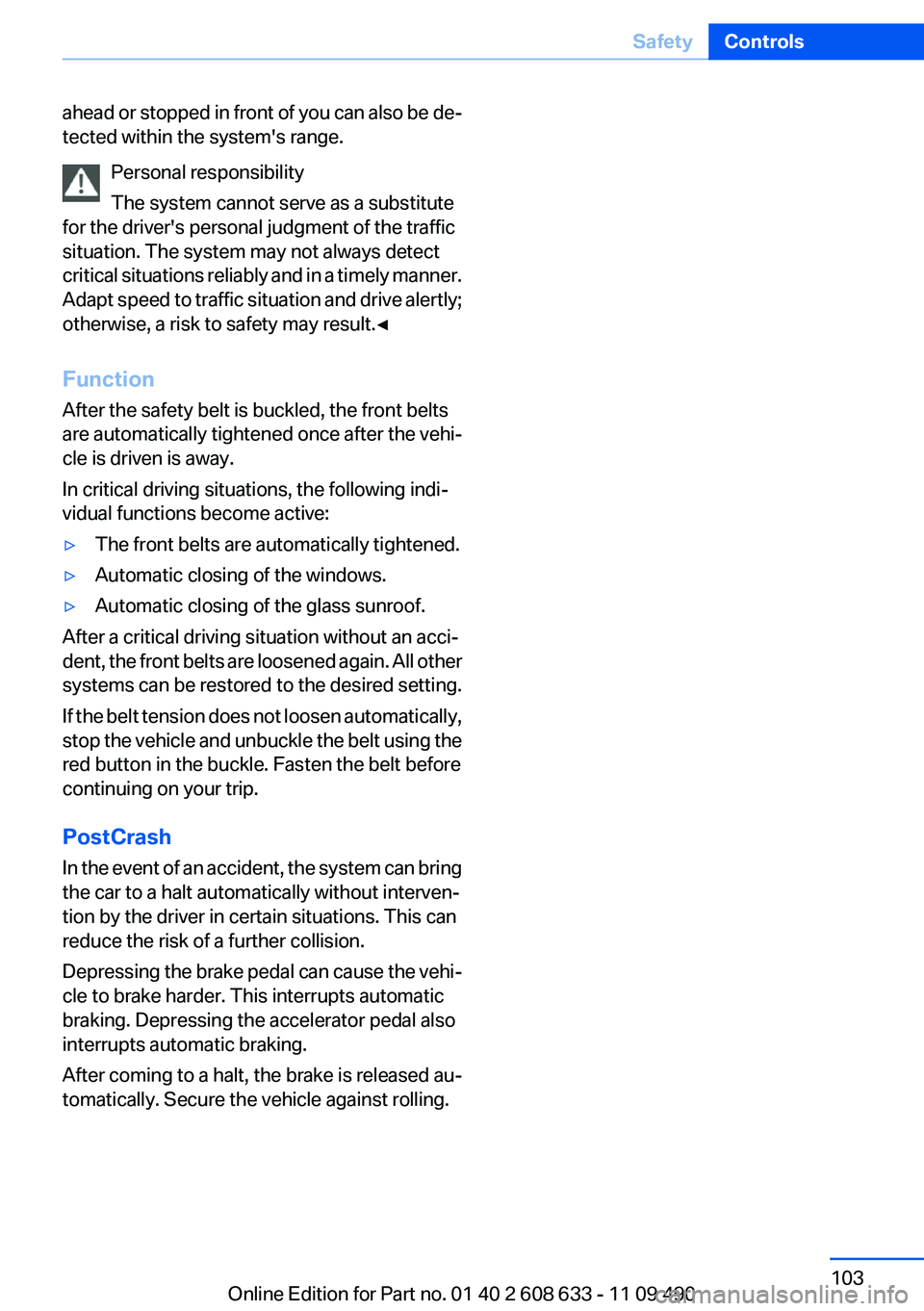
ahead or stopped in front of you can also be deтАР
tected within the system's range.
Personal responsibility
The system cannot serve as a substitute
for the driver's personal judgment of the traffic
situation. The system may not always detect
critical situations reliably and in a timely manner.
Adapt speed to traffic situation and drive alertly;
otherwise, a risk to safety may result.тЧА
Function
After the safety belt is buckled, the front belts
are automatically tightened once after the vehiтАР
cle is driven is away.
In critical driving situations, the following indiтАР
vidual functions become active:тЦ╖The front belts are automatically tightened.тЦ╖Automatic closing of the windows.тЦ╖Automatic closing of the glass sunroof.
After a critical driving situation without an acciтАР
dent, the front belts are loosened again. All other
systems can be restored to the desired setting.
If the belt tension does not loosen automatically,
stop the vehicle and unbuckle the belt using the
red button in the buckle. Fasten the belt before
continuing on your trip.
PostCrash
In the event of an accident, the system can bring
the car to a halt automatically without intervenтАР
tion by the driver in certain situations. This can
reduce the risk of a further collision.
Depressing the brake pedal can cause the vehiтАР
cle to brake harder. This interrupts automatic
braking. Depressing the accelerator pedal also
interrupts automatic braking.
After coming to a halt, the brake is released auтАР
tomatically. Secure the vehicle against rolling.
Seite 103SafetyControls103
Online Edition for Part no. 01 40 2 608 633 - 11 09 490
Page 156 of 325
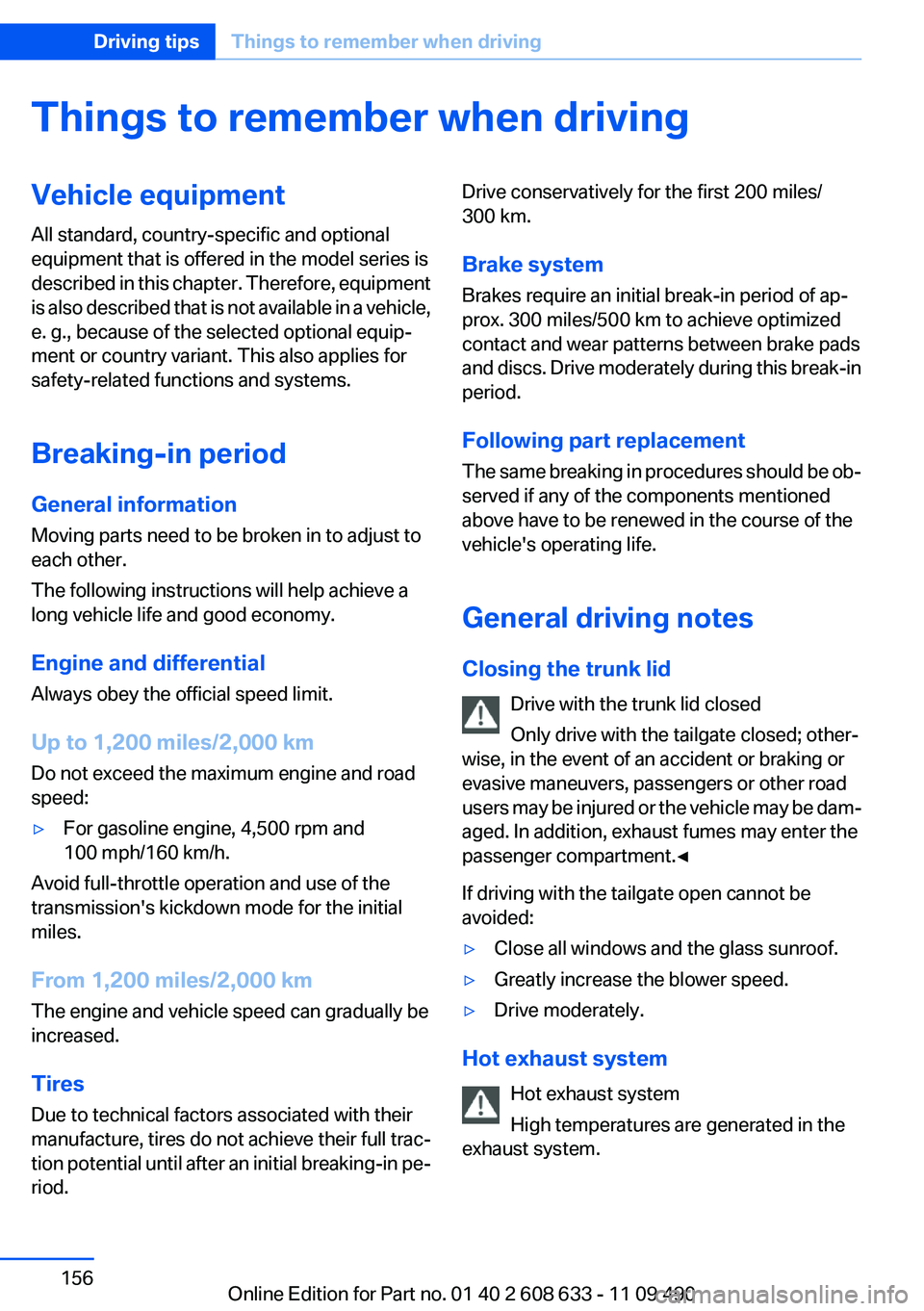
Things to remember when drivingVehicle equipment
All standard, country-specific and optional
equipment that is offered in the model series is
described in this chapter. Therefore, equipment
is also described that is not available in a vehicle,
e. g., because of the selected optional equipтАР
ment or country variant. This also applies for
safety-related functions and systems.
Breaking-in period
General information
Moving parts need to be broken in to adjust to
each other.
The following instructions will help achieve a
long vehicle life and good economy.
Engine and differential
Always obey the official speed limit.
Up to 1,200 miles/2,000 km
Do not exceed the maximum engine and road
speed:тЦ╖For gasoline engine, 4,500 rpm and
100 mph/160 km/h.
Avoid full-throttle operation and use of the
transmission's kickdown mode for the initial
miles.
From 1,200 miles/2,000 km
The engine and vehicle speed can gradually be
increased.
Tires
Due to technical factors associated with their
manufacture, tires do not achieve their full tracтАР
tion potential until after an initial breaking-in peтАР
riod.
Drive conservatively for the first 200 miles/
300 km.
Brake system
Brakes require an initial break-in period of apтАР
prox. 300 miles/500 km to achieve optimized
contact and wear patterns between brake pads
and discs. Drive moderately during this break-in
period.
Following part replacement
The same breaking in procedures should be obтАР
served if any of the components mentioned
above have to be renewed in the course of the
vehicle's operating life.
General driving notes
Closing the trunk lid Drive with the trunk lid closed
Only drive with the tailgate closed; otherтАР
wise, in the event of an accident or braking or
evasive maneuvers, passengers or other road
users may be injured or the vehicle may be damтАР
aged. In addition, exhaust fumes may enter the
passenger compartment.тЧА
If driving with the tailgate open cannot be
avoided:тЦ╖Close all windows and the glass sunroof.тЦ╖Greatly increase the blower speed.тЦ╖Drive moderately.
Hot exhaust system
Hot exhaust system
High temperatures are generated in the
exhaust system.
Seite 156Driving tipsThings to remember when driving156
Online Edition for Part no. 01 40 2 608 633 - 11 09 490
Page 162 of 325
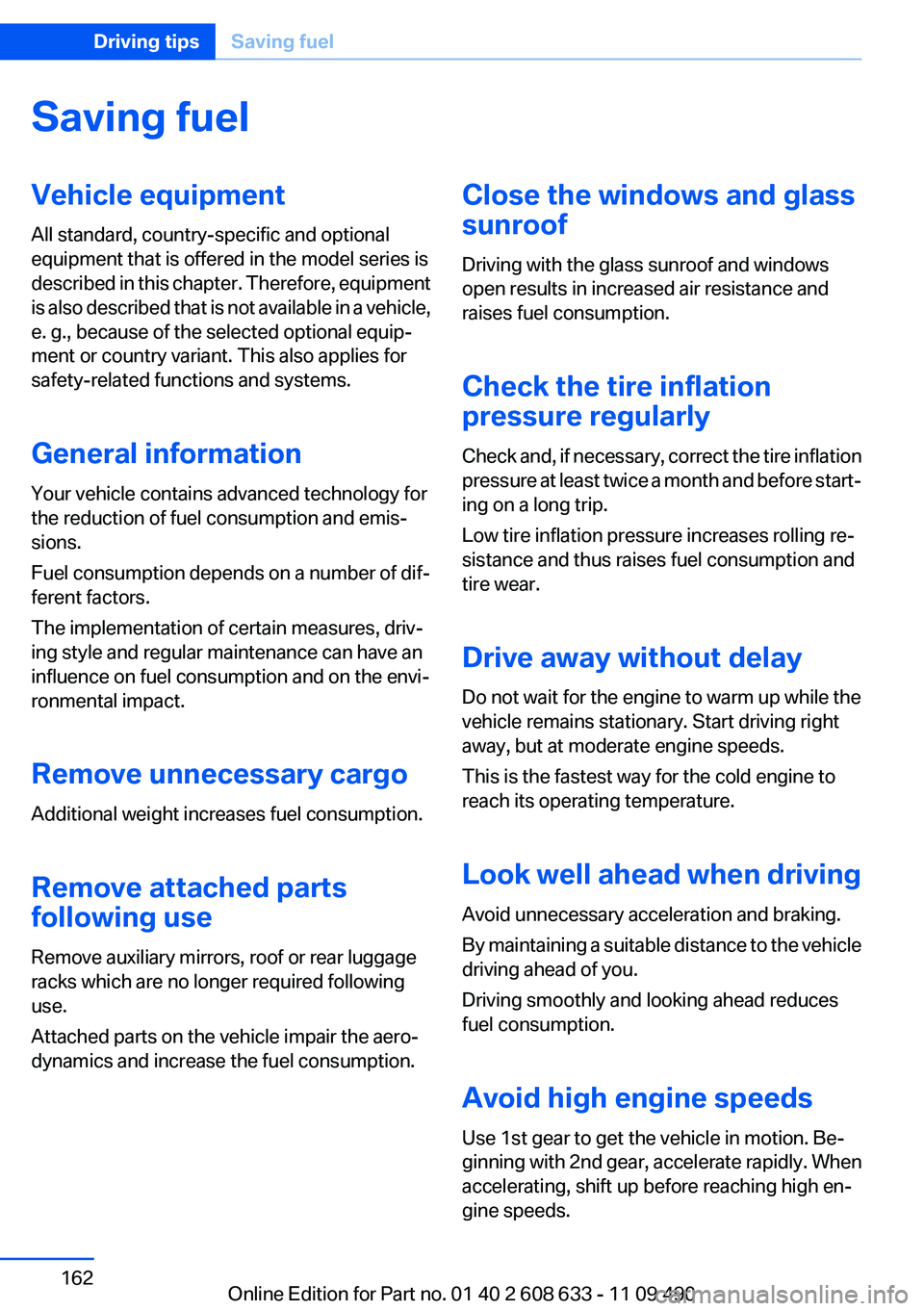
Saving fuelVehicle equipment
All standard, country-specific and optional
equipment that is offered in the model series is
described in this chapter. Therefore, equipment
is also described that is not available in a vehicle,
e. g., because of the selected optional equipтАР
ment or country variant. This also applies for
safety-related functions and systems.
General information
Your vehicle contains advanced technology for
the reduction of fuel consumption and emisтАР
sions.
Fuel consumption depends on a number of difтАР
ferent factors.
The implementation of certain measures, drivтАР
ing style and regular maintenance can have an
influence on fuel consumption and on the enviтАР
ronmental impact.
Remove unnecessary cargo
Additional weight increases fuel consumption.
Remove attached parts
following use
Remove auxiliary mirrors, roof or rear luggage
racks which are no longer required following
use.
Attached parts on the vehicle impair the aeroтАР
dynamics and increase the fuel consumption.Close the windows and glass
sunroof
Driving with the glass sunroof and windows
open results in increased air resistance and
raises fuel consumption.
Check the tire inflation
pressure regularly
Check and, if necessary, correct the tire inflation
pressure at least twice a month and before startтАР
ing on a long trip.
Low tire inflation pressure increases rolling reтАР
sistance and thus raises fuel consumption and
tire wear.
Drive away without delay
Do not wait for the engine to warm up while the
vehicle remains stationary. Start driving right
away, but at moderate engine speeds.
This is the fastest way for the cold engine to
reach its operating temperature.
Look well ahead when driving
Avoid unnecessary acceleration and braking.
By maintaining a suitable distance to the vehicle
driving ahead of you.
Driving smoothly and looking ahead reduces
fuel consumption.
Avoid high engine speeds
Use 1st gear to get the vehicle in motion. BeтАР
ginning with 2nd gear, accelerate rapidly. When
accelerating, shift up before reaching high enтАР
gine speeds.Seite 162Driving tipsSaving fuel162
Online Edition for Part no. 01 40 2 608 633 - 11 09 490
Page 317 of 325
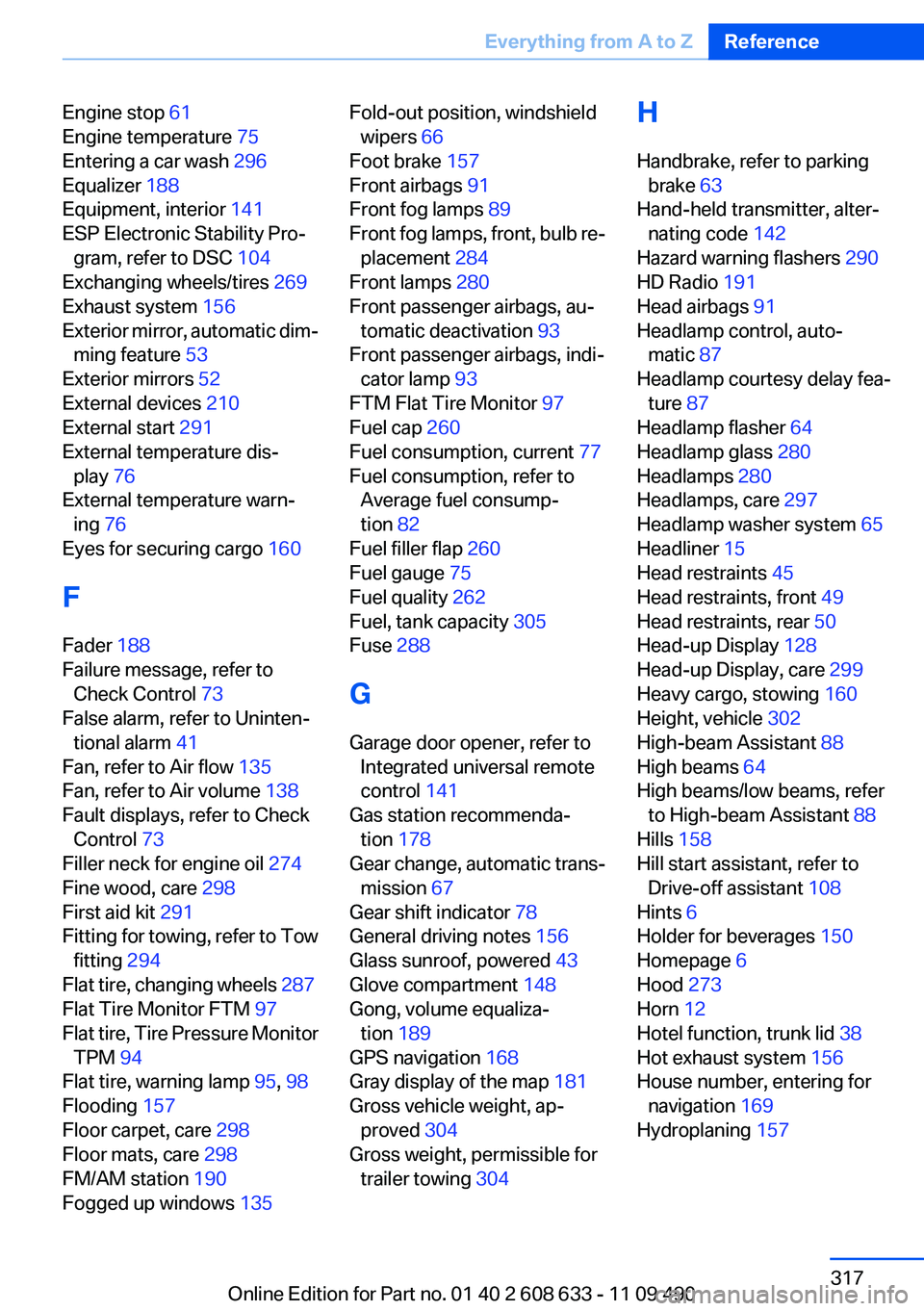
Engine stop 61
Engine temperature 75
Entering a car wash 296
Equalizer 188
Equipment, interior 141
ESP Electronic Stability ProтАР gram, refer to DSC 104
Exchanging wheels/tires 269
Exhaust system 156
Exterior mirror, automatic dimтАР ming feature 53
Exterior mirrors 52
External devices 210
External start 291
External temperature disтАР play 76
External temperature warnтАР ing 76
Eyes for securing cargo 160
F
Fader 188
Failure message, refer to Check Control 73
False alarm, refer to UnintenтАР tional alarm 41
Fan, refer to Air flow 135
Fan, refer to Air volume 138
Fault displays, refer to Check Control 73
Filler neck for engine oil 274
Fine wood, care 298
First aid kit 291
Fitting for towing, refer to Tow fitting 294
Flat tire, changing wheels 287
Flat Tire Monitor FTM 97
Flat tire, Tire Pressure Monitor TPM 94
Flat tire, warning lamp 95, 98
Flooding 157
Floor carpet, care 298
Floor mats, care 298
FM/AM station 190
Fogged up windows 135 Fold-out position, windshield
wipers 66
Foot brake 157
Front airbags 91
Front fog lamps 89
Front fog lamps, front, bulb reтАР placement 284
Front lamps 280
Front passenger airbags, auтАР tomatic deactivation 93
Front passenger airbags, indiтАР cator lamp 93
FTM Flat Tire Monitor 97
Fuel cap 260
Fuel consumption, current 77
Fuel consumption, refer to Average fuel consumpтАР
tion 82
Fuel filler flap 260
Fuel gauge 75
Fuel quality 262
Fuel, tank capacity 305
Fuse 288
G
Garage door opener, refer to Integrated universal remote
control 141
Gas station recommendaтАР tion 178
Gear change, automatic transтАР mission 67
Gear shift indicator 78
General driving notes 156
Glass sunroof, powered 43
Glove compartment 148
Gong, volume equalizaтАР tion 189
GPS navigation 168
Gray display of the map 181
Gross vehicle weight, apтАР proved 304
Gross weight, permissible for trailer towing 304 H
Handbrake, refer to parking brake 63
Hand-held transmitter, alterтАР nating code 142
Hazard warning flashers 290
HD Radio 191
Head airbags 91
Headlamp control, autoтАР matic 87
Headlamp courtesy delay feaтАР ture 87
Headlamp flasher 64
Headlamp glass 280
Headlamps 280
Headlamps, care 297
Headlamp washer system 65
Headliner 15
Head restraints 45
Head restraints, front 49
Head restraints, rear 50
Head-up Display 128
Head-up Display, care 299
Heavy cargo, stowing 160
Height, vehicle 302
High-beam Assistant 88
High beams 64
High beams/low beams, refer to High-beam Assistant 88
Hills 158
Hill start assistant, refer to Drive-off assistant 108
Hints 6
Holder for beverages 150
Homepage 6
Hood 273
Horn 12
Hotel function, trunk lid 38
Hot exhaust system 156
House number, entering for navigation 169
Hydroplaning 157 Seite 317Everything from A to ZReference317
Online Edition for Part no. 01 40 2 608 633 - 11 09 490